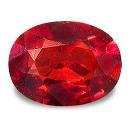|
ClassicGems.net |
|
|
 |
|
Spinel |
|
|
Discovered in 1546; IMA status: Valid (pre-IMA; Grandfathered) |
|||
|
|
|
Chemistry |
|
|
|
|
|
MgAl2O4 |
|
|
|
Magnesium Aluminum Oxide |
|
Molecular Weight: |
142.27 gm |
|
Composition: |
Magnesium |
17.08 % |
Mg |
28.33 % |
MgO |
|
|
Aluminum |
37.93 % |
Al |
71.67 % |
Al2O3 |
|
|
Oxygen |
44.98 % |
O |
|
|
|
|
|
100.00 % |
|
100.00 % |
= TOTAL OXIDE |
|
|
|
||||
|
Classification |
|
|
|
|
|
Oxides |
|
|
4/B.01-10 |
|
|
|
4 : OXIDES (Hydroxides, V[5,6] vanadates, arsenites, antimonites,
bismuthites, sulfites, selenites, tellurites, iodates) |
|
Related to: |
Spinel Subgroup. Gahnite-Spinel Series. Spinel-Hercynite Series. Magnesiochromite-Spinel Series |
|
Members of Group: |
Spinel Subgroup: Chromite, Cochromite, Coulsonite, Cuprospinel, Dellagiustaite, Franklinite, Gahnite, Galaxite, Hercynite, Jacobsite, Magnesiochromite, Magnesiocoulsonite, Magnesioferrite, Magnetite, Manganochromite, Spinel, Thermaerogenite, Trevorite, Vourelainenite, Zincochromite. |
|
Varieties: |
Akerite, Alkali Spinel, Almandine Spinel, Aluminum Spinel, Ceylonite, Chlorospinel, Corundolite, Ferropicotite, Gahnospinel, Hercynite, Iron Spinel, Iron-magnesia Spinel, Kreittonite, Magnesian Chromian Spinel, Magnochromite, Picotite, Pleonast, Rozircon, Titano-spinel, Zinc-spinel. |
|
Synonyms: |
Almandine, Balas Ruby, Candite, Ceylanite, ICSD 79000, PDF 21-1152, Rubicelle, Ruby Spinel, Spinelite, Spinella, Spinel-Ruby, Strongite, Talcspinel, Zeilanite. |
|
|
|
|
Crystal Data |
|
|
|
|
|
Commonly as octahedra, to 30 cm, may show dodecahedron or cube faces, rarely as dodecahedra; coarse granular, rounded, massive. |
|
|
On [111] as both twin and composition plane, the spinel law, penetration or contact, may be repeated as sixlings. |
|
|
|
|
|
Physical Properties |
|
|
|
|
|
None observed. Separation plane {111} indistinct and probably represents parting rather than cleavage. |
|
|
Irregular/Uneven to Splintery, Conchoidal |
|
|
Brittle |
|
|
7.5 - 8.0 |
|
|
3.58 - 4.10 (g/cm3) (increasing with Fe and Zn content) |
|
|
Reds and Pinks: crimson in LW UV and SW UV, red in X-rays, no phosphorescence. Blue: inert in UV. Deep Purple: red in LW UV, essentially inert in SW UV, lilac in X-rays. Pale Blue and Violet: green in LW UV and X-rays, essentially inert in SW UV. |
|
|
Not Radioactive |
|
|
|
|
|
Optical Properties |
|
|
|
|
|
Colorless, Red, Blue, Indigo, Violet, Green, Brown, Black |
|
|
Transparent, Translucent to Opaque |
|
|
Vitreous |
|
|
1.719; Isotropic |
|
|
0.000 - Isotropic minerals have no birefringence |
|
|
0.020 |
|
|
Usually None; anomalous in some blue zincian varieties. |
|
|
|
|
|
Occurances |
|
|
|
|
|
Geological Setting: |
A common mineral, formed at high-temperatures as an accessory in igneous rocks, principally basalts, kimberlites, peridotites, and in xenoliths; in regionally metamorphosed aluminum-rich schists; in regionally and contact metamorphosed limestones; a detrital mineral. |
|
Common Associations: |
Andalusite, Chondrodite, Corundum, Forsterite, Phlogopite, Scapolite, Sillimanite |
|
Common Impurities: |
Ti, Fe, Zn, Mn, Ca |
|
Type Locality: |
n/a |
|
Year Discovered: |
1546 |
|
View mineral photos: |
|
|
|
|
|
More Information |
|
|
|
|
|
|
|
|
|
|
|
Spinel is a member of the Spinel Subgroup of minerals that also includes Chromite, Franklinite, Gahnite and Magnetite, among many others. Spinel is a historically important gem because it has been mistaken for Ruby in some very famous crown jewel collections. Perhaps the most famous of these is the Black Princes's Ruby set in the British Imperial State Crown (Crown Jewels of England). It is estimated to be 170 carats. Originally thought to be a large Ruby, it was later proven to be a fine Spinel. Although Spinel gems are usually small, 3 carats or less, very large gems have been cut. The largest Spinel is probably the 520 carat gem found at the Banque Markazi in Teheran, Iran. Although Spinel is most famous for its red variety, it is also found in other colors such as green, blue, pink, purple, brown and black. A beautiful blue variety of Spinel is called "Cobalt Blue Spinel" but does not contain the element cobalt. The "Cobalt" simply refers to the color cobalt blue. A black variety of Spinel containing iron is called Pleonaste. Star Spinels and color-change Spinels are also (rarely) found. Spinel was named in 1779 by Jean Demeste from the latin word "spina" or "spinella" meaning "little thorn", alluding to its sharp octahedral crystals. Distribution: Many localities. Some for good specimens include: gem crystals from around Mogok, Myanmar (Burma). In Sri Lanka, in the Ratnapura and Elahera districts, and elsewhere. In the USA, at many places from Amity and Edenville, Orange County, New York to Andover, Allegany County, New Jersey; fine crystals from Franklin and Sterling Hill, Ogdensburg, Sussex County, New Jersey. From near Midland, and at the Crestmore quarry, Riverside County, California. In Canada, at Burgess, Ontario, and Wakefield, Quebec. In the Eifel district, and at Bodenmais, Bavaria, Germany. On Monte Somma and Vesuvius, Campania, Italy. From Andrahomana, Ambinda, Besakoa, and many other places in Madagascar. Large crystals from the Emeldjak and Katalakhu deposits, in the Aldan Shield, Sakha, Russia. At Gorondarinskoye, Pamir Mountains, Tajikistan. |
|
|
Spinel gems for sale: We have not photographed our Spinel gems. Please check back soon. |